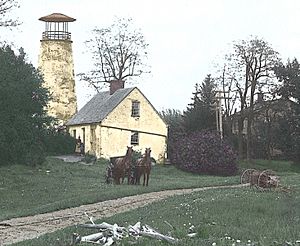Barcelona Light facts for kids
 |
|
| Historical View of Barcelona Lighthouse from the southwest | |
|
|
|
| Location | Barcelona Harbor on Lake Erie in Westfield (town), New York |
|---|---|
| Coordinates | 42°20′27″N 79°35′42″W / 42.34083°N 79.59500°W |
| Year first constructed | 1829 |
| Year first lit | 1829 |
| Deactivated | 1859 |
| Foundation | Natural emplaced |
| Construction | Fieldstone |
| Tower shape | Conical |
| Markings / pattern | Natural |
| Height | 40 feet (12 m) |
| Original lens | 11 lamps with 14-inch (360 mm) reflectors |
| ARLHS number | USA-038 |
The Barcelona Light, also known as the Portland Harbor Light, is a historic lighthouse located in Westfield, New York on the shores of Lake Erie. It's famous for being the very first lighthouse in the world to be powered by natural gas!
Contents
A Bright Idea: The Barcelona Lighthouse
The Barcelona Lighthouse has a fascinating story. It was built in 1829 thanks to the efforts of a man named Thomas B. Campbell. The lighthouse tower is shaped like a cone and was built using strong fieldstone. It also had a small cottage attached for the lighthouse keeper.
What made this lighthouse so special was its fuel. Instead of using oil, it was the first lighthouse anywhere to use natural gas! Thomas Campbell brought the gas from a "burning spring" about a mile away. He used wooden pipes to carry the gas to the lighthouse.
How the Gas Light Worked
In 1831, a special agreement was made to supply the lighthouse with natural gas all the time. People at the time were amazed by how bright and steady the light was.
The natural gas came from a "burning spring." This was a place where gas naturally came out of cracks in a rock near a small stream. Early settlers knew about this "burning spring" because they could light the gas with a flame.
To collect the gas for the lighthouse, people dug a small well, about 40 to 50 feet wide and 3 feet deep, over the spring. They built a tight stone cone over this well to trap the gas. Pipes were then used to carry the gas from the well all the way to the lighthouse, which was about 230 rods (or about three-quarters of a mile) away.
A special set of lamps was invented to burn the gas. These lamps had several arms that spread out like a fan, each with a brass pipe. You could control how much gas each burner used with a special valve. There were two rows of these lamps, seven on the bottom and six on the top. When seen from the lake at night, the whole tower looked like one big, steady flame!
Challenges and Changes
Even though the gas light was amazing, it had some problems. In 1838, there was a dry period, and the gas supply failed. This meant they had to switch back to using oil for a while.
By 1851, it was noted that water often collected in the gas pipes. When this happened, the gas couldn't pass through, and the lighthouse had to use oil lamps until the pipes were cleared.
Because of these issues, the Barcelona Light was stopped in 1859. The buildings were later sold in 1872.
Today's Lighthouse
Even though it was deactivated a long time ago, the Barcelona Lighthouse still stands today. After being owned privately for over 100 years, it is now owned by the New York State Office of Parks, Recreation, and Historic Preservation.
The lighthouse was recognized as an important historical site in 1972 when it was added to the National Register of Historic Places.


